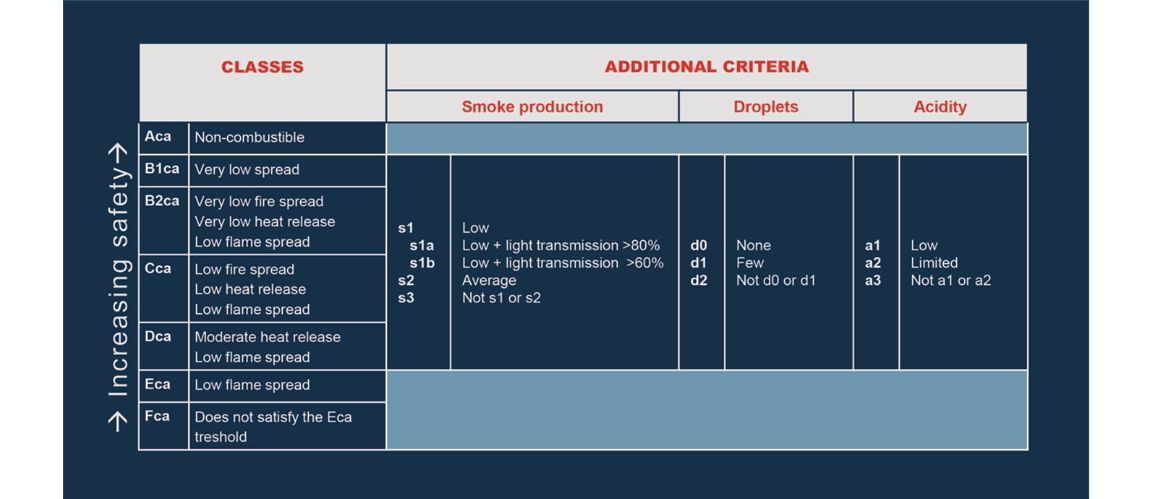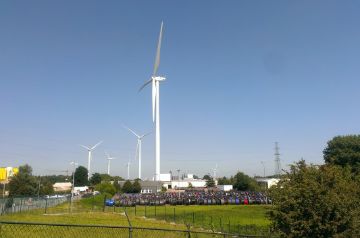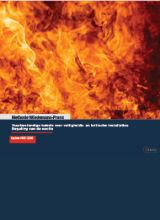- Products
- Markets
- Newsroom
- Tools & Resources
- CSR
- About Nexans
- Search
- Contact us
- Compare
- Sign in
Increased safety
The main cause of casualties in fires inside buildings is smoke and dangerous gases that significantly reduce the chance of escape and also cause damage to installations and goods far from the actual fire source. The contribution of cables is essential for both active and passive protection.
After all, they are present everywhere and in large quantities. Because they run through walls, in the event of a fire they can be the vector along which the fire can spread throughout the building. And all these cables represent a considerable amount of fuel for fire.
However, cables are not dangerous in themselves if they are adapted to the application and are installed correctly. Research proves time and again that cables with improved fire behaviour make a non-negligible contribution to containing the fire and reducing the formation of dense smoke and irritating gases or to keeping the electrical circuits intact.
Under the brand name ALSECURE® Nexans offers an extensive and continuously innovative range of safety cables. This range includes both our cables with an improved fire reaction and our fire resistant cables. As with all our other cables, for the cables in the ALSECURE® range we pay particular attention to processability for fast and efficient installation.
The 3 concepts of fire safety
It is important to understand the fire behaviour of cables and to what extent, once exposed to fire, they will contribute to the further development of the fire or influence the consequences of the fire. When working to improve the extent to which a cable contributes to fire safety, 3 parameters are essential: fire spread, smoke production and fire resistance.
Fire spread
Cables run through the whole building, through walls, from floor to floor. They can form the path through which a fire spreads to adjacent rooms or floors. Cables that do not propagate fire are called fire retardant.
Smoke production
Smoke developments mainly influences the effects of a fire. The hot smoke gases that are produced during a fire fill a building within minutes and are often black and impenetrable. This makes orientation difficult and evacuation even more difficult. Moreover, breathing in even small amounts of smoke makes you drowsy and short of breath, which further hampers a smooth evacuation. Did you know that the majority of deaths in a fire are due to inhalation of the combustion gases rather than death by combustion?
Smoke, moreover, is not only harmful to people. The corrosive gases that are released will also corrode the building's equipment and structure, so that even in a relatively small fire, the smoke damages can still irreparably degrade the entire building (and the machinery within it!). Electronics are particularly sensitive to corrosive gases.
Reducing the amount of smoke and toxic gases and their heat is therefore the key to saving lives and limiting material damage: it allows people more time for a smooth and safe evacuation and facilitates the work of rescue teams and fire fighters.
In short: cables with reduced smoke production:
- Provide a smoke-free escape route
- Protect the structure of the building
- Limit the smoke damages to equipment
- Facilitate the work of firefighters in the building.
Related document
“ Cables with low smoke production and which are also non-corrosive are called halogen-free cables. These produce less smoke in the event of a fire and are also less hot and non-corrosive.
All Nexans' ALSECURE® cables are halogen-free and non-flammable. ”
Fire resistance
In order to ensure that fire safety systems such as emergency lighting, video surveillance, call systems, alarm signals, sprinkler pumps, smoke extraction systems, etc. remain operational during evacuation and firefighting, their cabling must retain the capacity to perform its function of transmitting energy or signals despite exposure to fire. This is called the functional integrity or fire resistance of cables.
Take note:
The three parameters of fire spread, smoke production and fire resistance are independent of each other. If your cable scores well on, for example, fire spread, it will not automatically also score well on the other two parameters.
“ It is only logical that a fire-resistant cable feeding a smoke extraction system, for example,
should not - when it is itself exposed to fire -
further spread the fire nor produce additional smoke.
For this reason, fire-resistant cables must also be halogen-free and fire retardant. ”
CPR
EU n°305/2011 Construction Products Regulation
To which products does the CPR apply?
The CPR applies to all construction products that are permanently incorporated into buildings or civil engineering works (e.g. bridges or tunnels) and thus also to cables: not only power cables but also control cables, communication and fibre optic cables are covered by the CPR when permanently installed in a construction work.
Which cable performances are covered by the CPR?
The harmonised standard for cables EN50575:2014/A1:2016 only specifies requirements for the fire reaction of cables. For this purpose, threshold values are defined for a number of parameters. Based on these threshold values, cables are classified into 7 fire performance levels, the so-called fire classes.
At present, fire resistant cables are explicitly excluded from the CPR.
CPR defines, national legislators choose
The CPR only aims to harmonise technical product information by providing common tests and a common technical language to describe performance levels. The imposition of a performance level in a specific installation environment remains the prerogative of the national regulators.
CPR classes
Cables subject to the CPR are classified into classes of reaction-to-fire performance on the basis of threshold values defined by NBN EN 13501-6:2014.
The tests take into account the complete behaviour of cables during a fire, dynamically measured in time and in real installation conditions. This is an important step forward in fire safety.
The degree of contribution to the development of the fire is classified in descending order from Aca to Fca on the basis of the following classification criteria:
- Vertical flame spread
- Heat release
- Fire spread
Class Aca is attributed to cables “that do not burn”, with a low gross heat of combustion according to EN ISO 17016. Do not confuse this with fire-resistant cables.
Classes B1ca, B2ca, Cca and Dca are tested against increasingly lower requirements, class B1ca offering the best performance.
Cables in class Eca only meet the minimum requirements.
In class Fca, cables are classified which do not meet the requirements of the higher classes and are therefore highly flammable.
Additional classification
Only for fire performance classes B1ca to Dca additional characteristics can be tested. This additional classification is designated by a letter:
- s ("smoke"): Smoke production, with possible levels s1, s1a, s1b, s2 and s3.
- d ("droplets"): Flaming droplets/particles, possible levels being d0, d1 and d2.
- a ("acidity"): Acidity and conductivity, with possible levels a1, a2 and a3.
For the three characteristics s, d and a, the lowest index number indicates the best performance. The highest index number stands for "no performance determined" or for not meeting the requirements.
“ Halogen-free cables are those having obtained the additional classification s1+a1. ”

Combining the 7 performance classes with the additional classification theoretically results in 183 possible fire performance levels, from which the legislator can choose. In practice, national legislators have only included a few in their legislation.
In Belgium, the new AREI/RGIE 2020 prescribes the following CPR compliant fire performances (Section 4.3.3. Fire protection):
- Cca-s1, d2, a1 = halogen-free cables
- Cca-s3, d2, a3
- Eca
AREI/RGIE 2020
Summary of main fire protection provisions applicable to cables set by the General Regulation on Electrical Installations.
General Regulation on Electrical Installations
In Belgium, the General Regulation on Electrical Installations (AREI/RGIE) is the fundamental national legislation concerning fire safety.
The fire protection provisions apply to any room and to any electrical installation, such as fixed, temporary, indoor, outdoor, mobile or movable installations.
The owner, manager or operator must also explicitly prove the correct choice and installation of the electrical material and equipment in terms of fire protection. This is done on the basis of the electrical file, which also includes the risk analyses.
Provisions with regard to fire reaction
The new AREI/RGIE 2020 includes both the CPR classification with the fire-performance classes and additional classification and the old classification of the fire reaction according to NBN C30-004.
The cables that fall under the CPR are obliged to follow this CPR classification.
The AREI/RGIE prescribes 3 performance levels:
- Separately installed insulated conductors and cables have to be at least Eca.
- Insulated conductors and cables installed in bundles or layers have to be minimum Cca-s3,d2,a3.
- Halogen-free insulated conductors and cables are required by Table 4.10. in
- evacuation routes in construction works (e.g. staircases and corridors) with the exception of those located within the residential units,
- premises accessible to the public which can receive at least 50 persons (think of seminar rooms, sports halls, theatres...),
- tunnels considered as structural works
and are therefore minimum Cca-s1,d2,a1.
In addition, Cca-s1,d2,a1 is also mandatory in spaces which, according to the risk analysis, would be difficult to evacuate because of the smoke production in case of fire.
The old classifications F1, F2 and SA, SD are only applicable for cables that are explicitly excluded from the CPR, such as cables with fire resistance.
Provisions for fire resistance & functional integrity
The AREI/RGIE 2020 requires for fire resistant cables to be FR1 or FR2 according to NBN C 30-004. In addition, their fire reaction must be F2, SA and SD.
With regard to the guaranteed duration of the functional integrity, the AREI/RGIE refers to "other reference frameworks". Examples are the Basic Standards (minimum 1 hour) or the Hospital Act (2 hours) or regional decrees. This means that the de facto minimum duration functional integrity is 1 hour.
The concept of “vital installations” from the old AREI/RGIE has been replaced in the AREI/RGIE 2020 by 2 new concepts:
- the safety installations that have the safety of persons as their objective
- the critical installations that aim to ensure the safety of production goods (e.g. server rooms, cattle stables, chemical processes, etc.).
In both cases, these are installations for detection, reporting, warning, alarm, door release, smoke extraction, overpressure and underpressure, safety lighting, etc.
On the basis of the legal requirements and the risk analysis, the safety installations and/or critical installations and the required time of functional integrity are determined.
AREI 2020 published by FPS Economy (only in Dutch & French):
Cross-section determination of fire resistant cables
When determining the section of fire-resistant cables, the increased resistance of the conductors and the increase in voltage drop due to the high temperatures that can be reached in a fire must be taken into account. The AREI/RGIE indicates that account must be taken of the compartment in which the greatest voltage drop occurs but it does not provide any concrete calculation method for the determination of the section.
Cablebel, the platform of Belgian cable manufacturers, recommends the Wiedemann-Franz method because it is based on the laws of physics. This method also takes compartments into account. The Wiedemann-Franz formula is only a possible approach to the problem and in no way implies disapproval of other rules of good practice.
Nexans EASYCALC, the free online tool for determining the correct cable cross-section, uses this Wiedemann-Franz method for the cross-section calculation of fire-resistant cables. Rely on EASYCALC to determine the correct cross-section of a fire-resistant cable!
Related document
ALSECURE®: the Nexans solutions
Every year, approximately 10,000 fires still break out in Belgium and most of the fatalities do not occur as a result of the fire, but as a result of suffocation caused by the smoke production. Therefore, it is literally a matter of life and death that buildings are equipped with cables that show an imporved fire behaviour with limited smoke emission. The selection of a 'simple' cable can make the difference between life and death. With high-quality cables with improved fire behaviour, Nexans is actively committed to increasing safety in buildings to protect people and property.
For applications requiring improved fire behaviour - for example for buildings with a complex structure or with many people or less mobile people - Nexans has brought together its best-performing cables under the name ALSECURE®. This range is further structured according to performance level.
- ALSECURE® wires and cables up to 1kV are minimum Cca-s1,d2,a1. They are halogen-free and can be installed in bundles.
- ALSECURE® Plus groups the fire resistant cables up to 1kV (FR2 according to NBN C30-004) with a functional integrity of Rf1h or Rf1h30. These cables are also fire retardant F2 and halogen-free SA+SD according to NBN C30-004.
- ALSECURE® Premium are 500V fire resistant cables (FR2 acc. NBN C30-004) with a functional integrity of Rf2h. These cables are also fire retardant F2 and halogen-free SA+SD according to NBN C30-004.
Our Fire safety solutions:
Documentation
Our websites
Select your country to find our products and solutions
-
Africa
- Africa
- Ghana
- Ivory Coast
- Morocco
- North West Africa
- Americas
- Asia
- Europe
- Oceania




